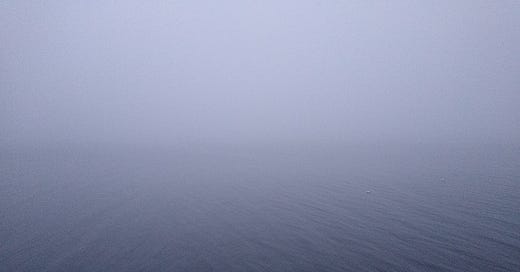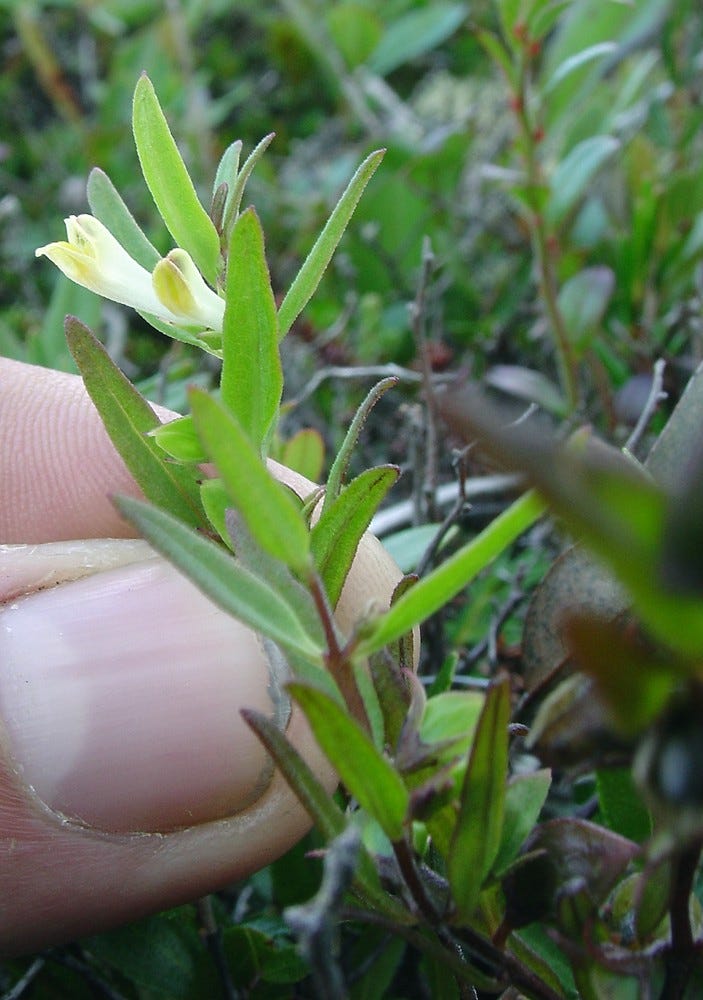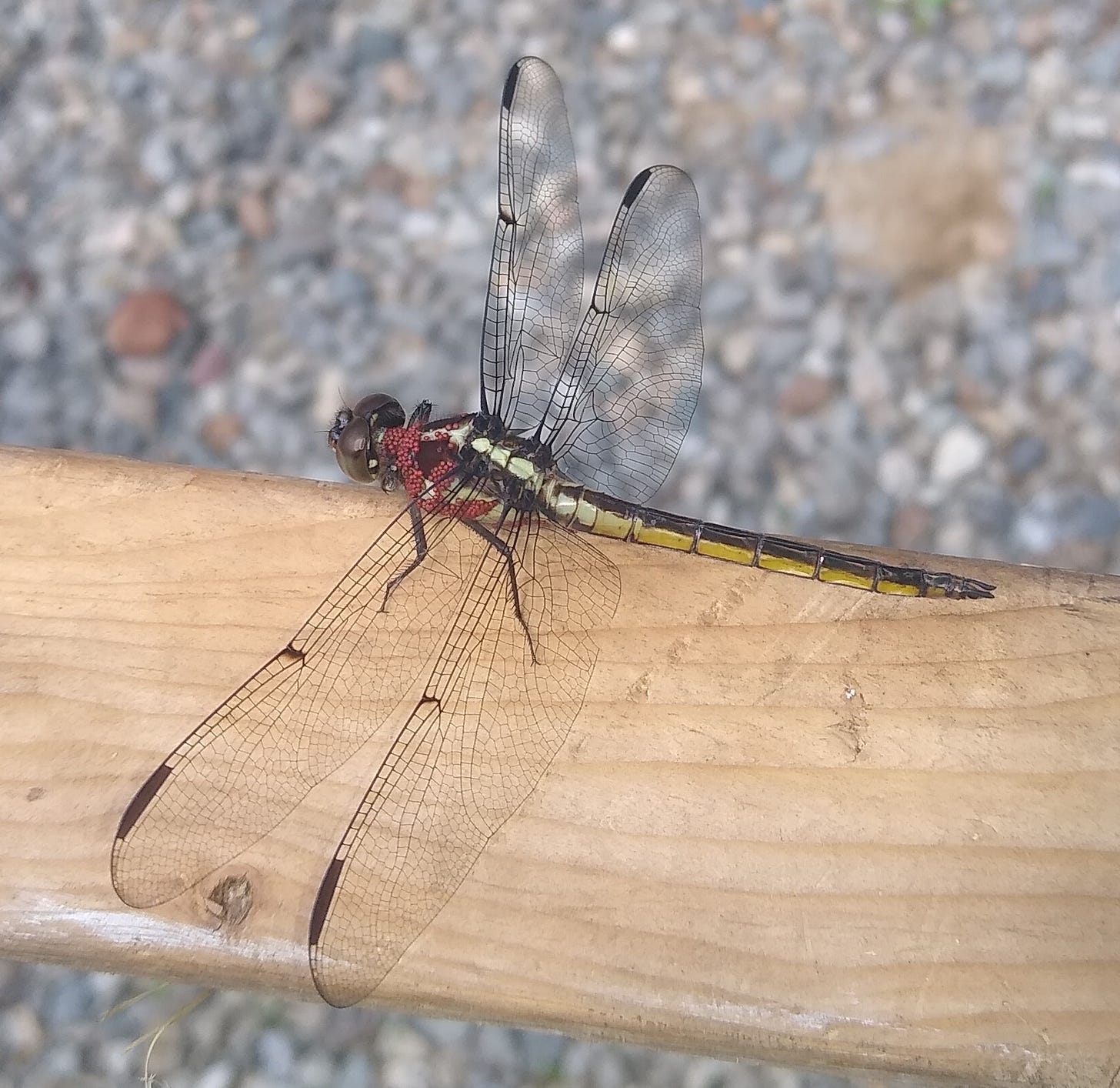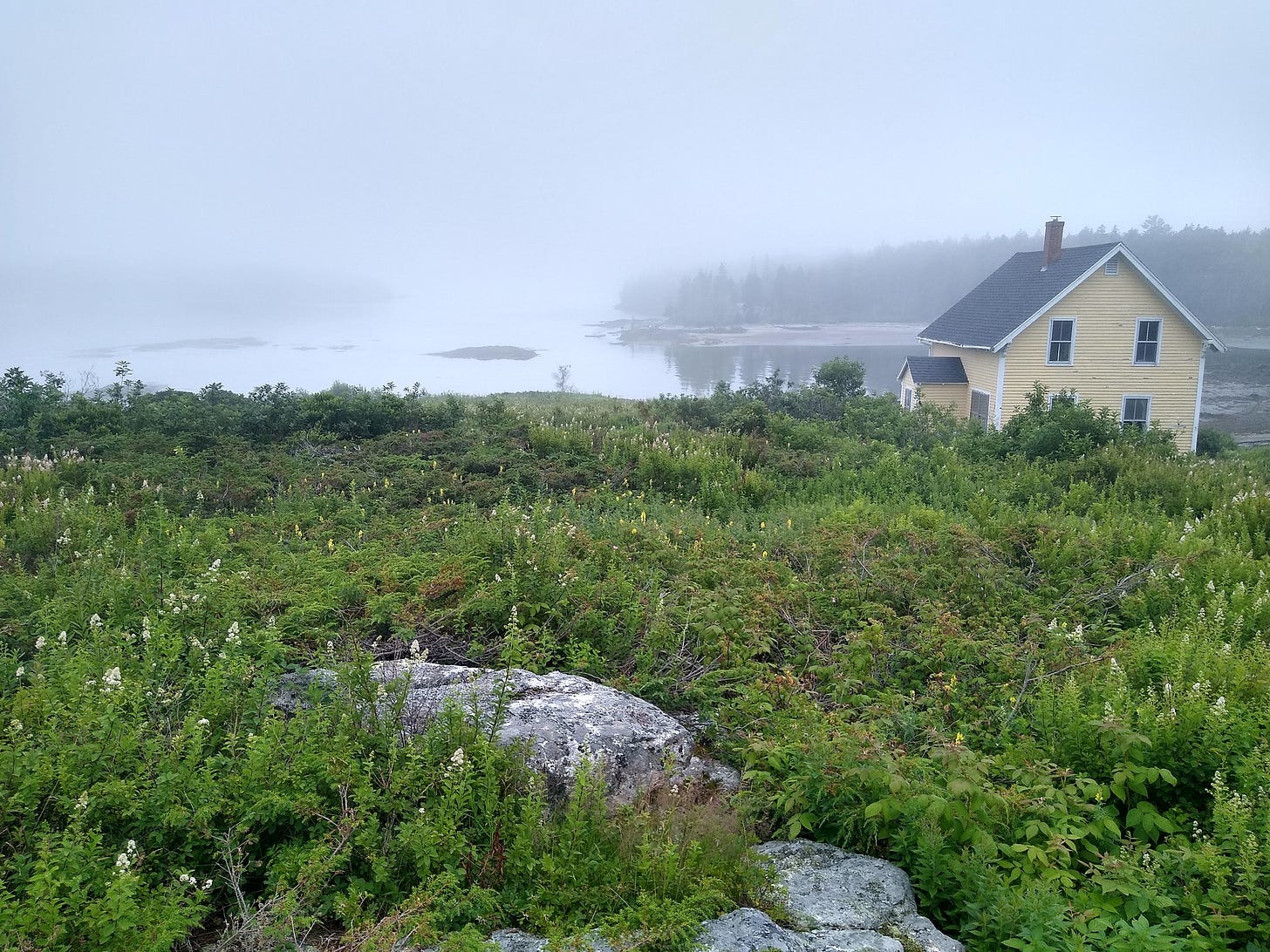Hello everyone:
As always, please remember to scroll past the end of the essay to read some curated Anthropocene news.
Now on to this week’s writing:
Heather and I spent last week on the island, the first part of it in the swirling murk of fog and rain that swamped this region for all of June and early July. But every damp moment was wonderful. From our porch, just feet from the water, islands in the bay were loon-haunted apparitions. Osprey, eagles, gulls, guillemots, and cormorants drifted through the greyness of sky and water. Our vegetable garden at home was half-drowned, but the well-watered wild botany on the island (where soils are thin and often dry) has thrived in the tropical precipitation. On the slope between the cottage and the snug harbor, vibrant milkweed and six-foot-tall sweet clover were vibrating with bumblebees and other pollinators. All week, we looked at bugs and plants, took some foggy walks, read and relaxed.
Meanwhile, folks in Phoenix were suffering and dying from severe burns after falling or collapsing onto the pavement. Temps there have reached 110°F every day for nearly a month now, and heat-related deaths across the south and southwest are increasingly common. Workers and hikers and prisoners are being baked to death. A sixth of Americans are living in dangerous heat this week. (Remember that heat kills more people than other types of extreme weather.)
Elsewhere, Arctic and Antarctic sea ice is disappearing, parts of Texas and Iran had shocking heat index readings of over 150°F, and Greece, Algeria, and Canada were aflame. Parts of Vermont and Sichuan were underwater. In fact, innumerable cities and communities on three continents – not to mention many of the planet’s animals, plants, and ecosystems – were roasting, burning, drying up, and drowning in a planetary-scale hot mess whose intensity and frequency can only be blamed on our greenhouse gas emissions. “I'm not aware of a similar period when all parts of the climate system were in record-breaking or abnormal territory,” an environmental geographer told the BBC.
While I was vacationing in a lovely foggy bubble, in other words, the world was burning.
But I’m not here to talk about my privilege or guilt. I’m here, recently emerged from the fog, to talk about what has become excruciatingly clear about the near- and long-term fate of life on Earth. It’s a fate that’s been clearly predicted for decades – and thus avoidable – and it’s the fate of our children and grandchildren. The question is whether the shock of what’s here, and of what will hit us in the next few years, will be enough to push industrial civilization out of the fog too. There is much to do, and less time to do it.
If my tone this week is tougher than usual, it’s because I’m afraid that we’ll normalize this insanity rather than fight to change it.
The facts are as brutal as the weather. The spike in global temperature is certainly hotter than at any time in the last 40 years, probably hotter than the last 125,000 years, and perhaps even the last million years.
What’s even harder to contemplate is that this may be one of the coolest summers of the rest of our lives (not to mention the lives of those who will follow in our burning footprints). With another El Niño pattern settling in, and the world’s oceans heating up far too quickly – water temperatures near Key Largo, FL, just reached a record-setting, coral-killing, hot tub equivalent of 101°F – we seem quickly heading for a climate that correlates with our current atmospheric CO2 levels, which haven’t been seen on Earth since the mid-Pliocene, about three million years ago, when beech trees grew near the South Pole and camel ancestors roamed a forested Arctic.
If that sounds like alarmist fantasy, please understand I mean it literally. We’re fast-tracking a temperate climate for the north polar region. CO2 in the atmosphere has surpassed 420 ppm, which is 100 ppm more than when I was born. That’s a shift that normally takes tens of thousands of years. We may reach Eocene CO2 levels by 2100 – that’s a 60-million-year leap backward – when alligators and giant tortoises lived in what is now northern Canada.
Recent research suggests that, looking ahead, for every tenth of a degree increase in global temperatures, 140 million people will find themselves living in intolerable conditions. Humans have evolved within a range of temps that have blessed us with a habitable “Goldilocks” zone. Now imagine the population equivalent of Russia, say, or Mexico, being cast out of that zone for just a tenth of a degree. Now imagine that happening several times over in the next few decades (if we don’t radically reduce emissions), with the subsequent chaos in ecosystem declines, human health, forced migration, etc. If you live with scorched feet in Phoenix or Iran, that might not be too hard to imagine.
For an especially personal view on how we got here, read the somber note from
in on his decades of work as a climate Cassandra writing and talking about the coming crisis – his lifelong service to humanity, really – but arriving nonetheless at this moment of extraordinary suffering for far too many people:I wrote the first book on what we now call the climate crisis way back in 1989, and it feels like I’ve spent the subsequent three-and-a-half decades warning that eventually we’d get to this particular July: the hottest day and week and month on record…
When I read things like this, I weep for the people involved, and I also weep at my own failure. I’ve known about this crisis longer than almost anyone on earth, and I’ve done what I can think of to do, and some of it has been useful, but it hasn’t been enough. Others have done more and better, but that hasn’t been enough either.
Then there’s James Hansen, the 82-year-old American climate scientist whose pioneering research and testimony before Congress in 1988 initiated the battle for truth and good climate policy that McKibben has been fighting ever since. “These superstorms are a taste of the storms of my grandchildren,” he recently told the Guardian, “We are headed wittingly into the new reality – we knew it was coming.” More bluntly, he says “we are damned fools. We have to taste it to believe it.”
And here’s an Australian climate scientist telling the Guardian what haunts him:
I don’t know how many more warnings the world needs. It’s as if the human race has received a terminal medical diagnosis and knows there is a cure, but has consciously decided not to save itself.
But that’s the betrayed optimism of a scientist who still thinks that data shapes culture. (And someone who has forgotten that “the human race” includes those long-lived cultures who have always known better.) While it’s true that the crisis should be as obvious to everyone as the burnt skin in Phoenix and the ash in Canada, or as obvious as the 61,000 heat deaths in Europe last summer, or as obvious as the third of Pakistan that was underwater then, the problem isn’t so much that “the world” doesn’t care about its diagnosis. The problem, or part of it, is that the patient has for the last 40 years received a steady stream of profit-driven second opinions from the fossil fuel industry, its paid-for politicians, and our ill-informed or weak-kneed media.
The rest of the problem is that we’re not pissed off. We’re not pissed off because the transformation of the Earth is not a moral issue for us. It’s not a moral issue because we’re disconnected from the living world. And we’re disconnected from the living world because the only way we could have built this nature-devouring machine we call civilization was to convince ourselves that 1) the rules didn’t apply to us and that 2) we had a better plan.
The rules do apply to us – physics and ecology, particularly – and our plan is a catastrophe. That’s how we got here. But will the unfolding catastrophes, the hot and messy “uncharted territory” we’re in, and the clinical prognosis of a hotter and hotter Earth make this a moral issue that pisses us off?
We rarely say it out loud, but the bad philosophy that got us here is in the air we breathe, the food we eat, the clothes we wear, the politicians we support, the machines we build, and the fuel we pump: The world belongs to us. Only we matter. We choose who lives and who dies.
The alternative philosophy – we belong to the world – still exists within us. We feel it every time we marvel and wonder at a moth or its flame, take respite amid birds and trees, or find our dreams answered by the ocean. We remember it when, out of love, we slow down for animals in the road, and when, out of respect, we remove roadkill from the asphalt. We act on it when we protect our fellow species and the places they inhabit.
Indigenous cultures around the globe remember the old ways, despite hanging on by their fingernails in the Anthropocene whirlwind, and are doing their part by protecting much of what remains. We can pretend we’re better than they are in some way, but if our policies don’t produce the same results, we’ll still be falling off the cliff and calling it flying.
Ecologist and writer Aldo Leopold tried to bridge the gap, giving us a rational set of ethics to live by. Here’s one:
“A thing is right when it tends to preserve the integrity, stability, and beauty of the biotic community. It is wrong when it tends otherwise.”
That was from A Sand County Almanac, written in 1949, but much larger forces were at work then. The mid-20th-century was the era of the so-called Great Acceleration, when the true planetary scale and brute force of Anthropocene impacts kicked into high gear. Which means Leopold’s concern for the “biotic community” is still a foreign concept to the American mind. And no wonder, as Jack Turner wrote in a brilliant essay called “The Abstract Wild;” if we apply Leopold’s principle to human history, he says, “the last 10,000 years of history is evil.”
Turner published his essay in 1989, the same year that Bill McKibben wrote his first climate book, The End of Nature, and a year after James Hansen warned Congress to plan for what’s hitting us now. “The Abstract Wild” was in an issue of Witness magazine that I’ve held onto for over 30 years. The issue was titled “New Nature Writing,” and it included pieces by Barry Lopez, Terry Tempest Williams, Charles Bowden and other great, thoughtful writers who understood what was at stake in a radically transformed world.
Turner’s brilliant and wise essay (which later became a book with the same title) simmers with a barely-contained anger at a culture which accepts the destruction of the natural world and its replacement with the shallow, hollow, self-serving fragments we call zoos, aquaria, gardens, and national parks. Without the daily experience of the real world that has informed 99.9% of human history, we become an audience to the wild rather than a companion, participant, or sibling to it. And that’s why we don’t protest its loss:
Effective protests are grounded in a refusal to accept what is normal. We accept a diminished world as normal; we accept a diminished way of life as normal; we accept diminished human beings as normal. What was once considered pathological becomes statistically common… Decayed teeth are statistically common, just like smog and environmentally-caused cancers. That a statistically-common decayed tooth is also an abnormal tooth, a pathological tooth, a diminished tooth, a painful, horrible, mind-bending tooth, is a fact we ignore. Until it is our tooth. At present most of us do not experience the loss of the wild like we experience a toothache. That is the problem. The “normal” wilderness most people know is a charade of areas, zones, and management plans which is driving the real wild into oblivion, but we deny this, accepting the semblance instead of the demanding the real.
Climate change, as I’ve been noting here in the Field Guide since I began 119 weeks ago, is only one symptom of the larger planetary transformation. To consider it on its own as an existential threat is to forget what existence is and how it’s changed.
We will be told, and we will be tempted, to normalize the growing heat, like the proverbial frogs in the pot. It’s easier not to protest, easier not to spread the word, not to gather and yell. I don’t like protests. I prefer to sit in the fog looking at all that is lovely in life.
One of the lovely things that Heather and I marveled over on the island is a pretty and unassuming plant called cow-wheat, growing happily amid this year’s thriving low-bush blueberries. We learned that cow-wheat is a hemiparasite, a species that both feeds itself and takes energy from a host. Unsurprisingly, this got me thinking (and researching) about the Anthropocene.
Parasitism, you might be surprised to learn (as I was), is the most common form of animal life on Earth. That wasp laying eggs in a caterpillar is as natural and essential as the caterpillar. The cowbird laying eggs in another bird’s nest is living by an ancient and accepted strategy.
Humans are not parasites by nature, but we’ve developed a parasitic industrial culture. Perhaps more often demonstrating mutualism and commensalism for most of our species’ history, humans are omnivorous opportunists now experimenting with a destructive philosophy: The world belongs to us. Only we matter. We choose who lives and who dies.
And the pervasive nature of capitalism is such that we’re experimenting with parasitism at every level of existence. Thus racist and patriarchal politicians, thus chattel slavery and prison labor, thus rapacious private equity and insurance companies, thus corporate hierarchy, thus factory farms, feedlots, and Roundup-soaked corn monoculture, etc. Conservation, rewilding, racial justice, antitrust law, and voting rights are, arguably, all efforts to keep parasitic tendencies in modern culture from sucking their hosts dry.
Here’s a climate riddle for you: How fast we go is the future we get. On one hand, each tick upward in global temperatures increases the likelihood of even faster warming and greater suffering. On the other hand, the quicker we decarbonize, shut off the tap of greenhouse gases, and heal the planetary wounds, the more survivable the future becomes.
“The current horrors,” Bill McKibben says in his recent somber post, “are not a reason to stop working… And nothing has changed my basic conviction about the key:
we need to keep building huge movements to finally break the political power of the fossil fuel industry and force the emergency conversion to clean energy. When we’ve made progress—the Paris accords, say, or the Inflation Reduction Act—mass mobilizing is how we’ve done it; we have to give good politicians the room they need, we have to give bad politicians the boot, and we have to hold corporations accountable for killing us and our world. We have to keep on changing the zeitgeist.
“Those of us who understand, and who care, just have to keep trying – after all, what other choice do we have?” That’s the Australian climate scientist I quoted above. And he’s right, of course. Whether we act out of anger, love, respect, responsibility, or a rejection of parasitism, we have to act.
And there’s innumerable signs, thankfully, that we’re emerging from the fog. We’re late, but emerging nonetheless. Given a proper diagnosis, a clear-eyed prognosis, and a bit of courage, people will do the right thing. We only need to care enough to be pissed off. Here are just five random examples from recent news:
The International Seabed Authority has delayed final rulemaking for mining the deep sea, which likely puts off any mining permits until 2025. That may be enough time for the economics of this insanely destructive plan to collapse.
The powerful and intensifying effects of the Biden administration’s Bipartisan Infrastructure Law and Inflation Reduction Act are jumpstarting U.S. efforts to clean up its act. There’s more to do, but for the first time in U.S. history we’re on the right track.
The rapid domination of cheap clean energy – solar, wind, geothermal – in the energy markets will eventually make fossil fuel energy unnecessary. And if we can solve the wicked problems of petroleum-based plastics and fertilizer, then we can keep nearly all the oil, gas, and coal in the ground. The trick is to do it now.
There are countless small-scale conservation victories, like the thriving sandhill cranes that Aldo Leopold once described as on the verge of extinction. They’re now hanging out in backyards.
In this intense heat and drought, Arizona authorities are busy filling artificial watering holes for wildlife.
To what extent all this limits the ferocity of what’s coming, we will see. But we need to keep doing it, and more, amid our own great acceleration. How fast we go is the future we get.
“We’re riding the tiger at this point,” the great fire scholar Stephen Pyne says. “I think all of us are going to have to accept there’s going to be a lot more fire.” And a lot more heat and drought, water scarcity and flooding, migration and migrant-hating, etc. To prepare, you might check out this video interview on PBS with the author of The Heat Will Kill You First: Life and Death on a Scorched Planet.
In the meantime, remember that if the weather seems malevolent, it’s only holding up a mirror to our actions (and inaction). As McKibben says, we can pretend that human culture lives by other rules, but really, debating the climate crisis is like having a beef with physics, and physics never loses.
And remember also that we’re still surrounded by the wild, whether in the unseen myriad of moths or the quiet beauty of milkweed and sweet clover. All we have to do is look with attention and act with care.
Heather, for example, is leading nature walks for folks who are unfamiliar but enthusiastic, excited to emerge from the fog of their disconnection into the light and warmth of understanding. So should we all.
Thanks for sticking with me.
In other Anthropocene news:
For those of you here in New England, the UNH Extension Service is hosting the Eastern Old-Growth Conference, Sept 21-23, in Moultonborough, New Hampshire. These conferences are “dedicated to the study, awareness and appreciation of the original forests of the Eastern United States and Eastern Canada.”
From
at , his gorgeous essay “The Moth and the Flame” makes clear not merely how astonishing the world of moths is, but how well they represent the incredible beauty and diversity of life. And they’re on our doorstep, if only we’re willing to step into the light.I’ve only now discovered
and her lucid and articulate writing at On the Commons, but am already grateful to her for a discussion we had in a comments section, in which she 1) reminded me about Jack Turner’s writing, and 2) offered this beauty of a line: “The Anthropocene is coming for our dreams.” Here’s a little something about On the Commons:On the Commons explores ownership and its inevitable injustices. It looks at the losses of physical commons in tandem with human rights throughout history, and the little-known stories of people working right now to reclaim stolen commons and rebuild lifeways shaped by ethics of kinship and caregiving rather than ownership and domination.
From PBS, those 900 out-of-control wildfires in Canada are burning broad swathes of Indigenous territories, wreaking havoc on their way of life:
“In blink of eye, we lost so much … it was devastating. I can’t stress that enough,” said Supernault, who said he hasn’t seen any elk or moose, both important food sources, since the fire… “We don’t just jump in the car and go to the IGA,” for groceries, Supernault said. “We go to the bush.”
From Inside Climate News, hydropower is not the clean energy you think it is. Reservoirs, one expert says, are “giant methane factories.”
From Mother Jones and Reveal (from the Center for Investigative Reporting), the absurd and infuriating practice by U.S. federal agencies to satisfy renewable energy requirements by purchasing far too many RECs (renewable energy credits) from burning biomass and from CO2-spewing trash incinerators. When an incinerator operator describes his workplace this way – “If I could see hell, this is what it would look like” – he might as well be talking about the world’s most powerful country pretending to address a climate crisis that’s currently killing its citizens.
From the Times, a portrait of attorney Missy Sims, who is leading a class-action lawsuit against the major fossil fuel companies on behalf of several Puerto Rican communities devastated by Hurricane Maria. While hers is one of many lawsuits working to lay responsibility at the feet of the energy industry, it’s unique because she’s using powerful RICO charges – originally designed to prosecute organized crime – and because she’s connecting their actions to a specific weather event. If the RICO charges stick, as they did for the tobacco companies, it will change the game completely. Sims is interesting too because as an observant Catholic she considers God her co-counsel in all her work.
Also from the Times, 1) Arctic soils have been wormless for a very long time, but rapid warming has changed that, probably forever; 2) David Wallace-Wells explains how the devastating Canadian fire season is much worse than you think.
From Clean Technica, a reality check on how much methane leaks from many, many different points along the fossil fuel infrastructure that produces and transports it. Remember that so-called “natural gas” is mostly methane. It’s everywhere in our current energy systems, pretending to be a “clean” energy source, but all that leaking methane is an incredibly powerful greenhouse gas. There isn’t nearly enough motivation at the corporate or government policy level to tighten up the system. (And as a side note, this is the same industry that wants to build out an even larger pipeline infrastructure for moving captured CO2 …)











Great essay, Jason. I shared it on Facebook. Like my mom says of those fossil fuel oligarchs and their bought-off politicians who are so actively burning the Earth because it makes them richer, "Where do they think they will go? Where will their children and grandchildren go? They will suffer the consequences too. There is no other planet."
I am so moved by this essay, Jason. Your anger and your love burst through this and create a safe space for me to rest my own anger, love and grief and not feel so alone with it. So much has to happen so quickly I can barely breathe for all the work that needs to be done. We must change the narrative, the paradigms of those narratives and we must do it now. I wish I could plaster this essay all over the telephone poles and the storefront windows!